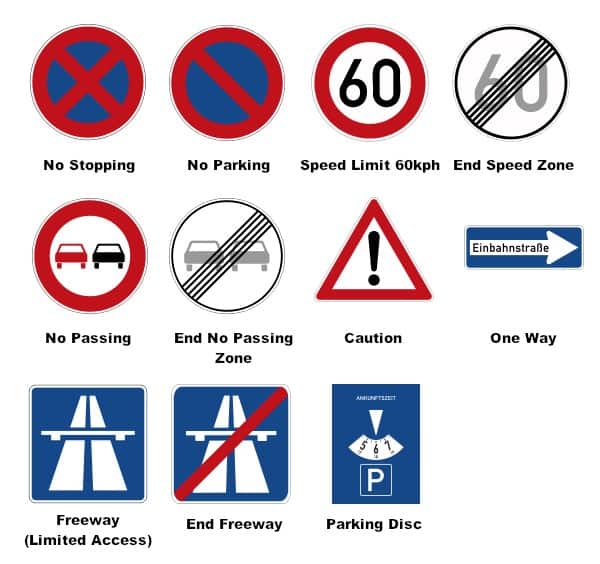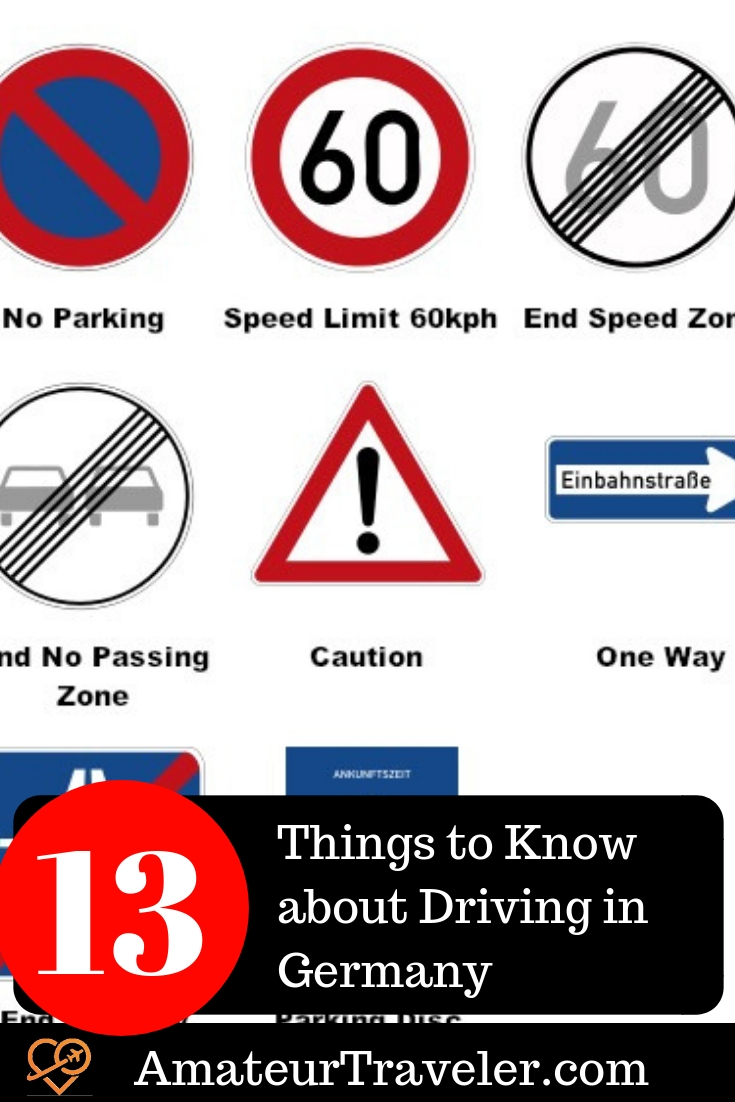Driving in Germany as a Tourist – German Road Signs and 12 Others Things to Know
categories: europe travelThe first thing to say is that Germany may be one of my favorite European countries to take a road trip. I have driven all over the country from its southern border to the former East Germany. In general, Germans are good drivers who follow the rules. Although… things can be a bit fast on the autobahn. German has a great train system but if you want to get out into the countryside, nothing beats having your own car.

Hainich National Park
Here are 13 tips about driving in Germany that I learned or re-learned on my road trip through eastern Germany collecting UNESCO World Heritage sites.
1. What side of the road does Germany drive on?
Germany, like the rest of continental Europe, drives on the right-hand side. In Europe, only the British Isles and Malta drive on the left-hand side.

2. German Road Signs
Because not everyone in the world speaks German, Germany, like most of Europe, relies heavily on international road signs. Many of these will be obvious to visitors but here are some that might trip you up if you don’t know them. The first time we drove in Europe it took us most of a day to figure out why they kept telling us “no sawhorses”. What they were really telling us was that we were coming to the end of a limited-access highway (End Freeway).

For a more exhaustive list to traffic signs check out Brian’s German Traffic Signs & Signals.

3. Timed Parking
The last of the road signs above is a critical one to know to avoid a parking ticket. A sign with a P on it is used to indicate parking, but some of these have this dial sort of indicator above it. With your rental car, you will receive a parking disk which is a blue sign with a movable white dial on it with times. When you park in an area marked with the parking disk it will indicate how long you can park. Before you leave your car you pull out your parking disk, set it to your arrival time, and place it on the dashboard of your car.

4. Speed Limits
The Autobahn is Germany’s great freeway system. Yes, what you heard is correct, many of the sections (but not all) of the Autobahn have no posted speed limit. The law does say:
Any person driving a vehicle may only drive so fast that the car is under control. Speeds must be adapted to the road, traffic, visibility and weather conditions as well as the personal skills and characteristics of the vehicle and load.
So you can get a speeding ticket on the Autobahn if you are driving too fast.
Off the Autobahn the default speed limit is 50 km/h (31 mph) in cities and 100 km/h (62 mph) in rural areas.
The only time I have personally had a problem on the Autobahn was near Nurenburg. We were driving fast as always and it started to rain. The drivers did not slow down and, rather predictably, someone ahead of us got into an accident on the slick roads. We were barely able to stop in time to avoid joining the accident.

5. The Left Lane is for Passing
You have probably heard how fast cars drive on the German Autobahn. That sounds great to some drivers and intimidating to others, but the fact is that German drivers are really pretty good and you should not be intimidated about driving in Germany. But you do need to know that the left lane of the highway is for passing. Don’t plan on just staying in that lane because there is always some driver who wants to pass you like ein Fledermaus out of Hell. This also means when you check your mirror to see if it is clear in that lane it is a good idea to check twice as you may underestimate how fast that car is coming.
6. Flash to Pass
If you forget the rule above don’t be surprised if the car behind you flashes their car’s high beams at you briefly. This is the signal that they want you to pull into the right lane so that they can pass you.
7. Slow Means Slow
Ironically, while Germans drive faster on the highway they sometimes drive slower in town. Many urban areas, like school zones, are marked as 30 kph or 18 mph. Personally, I am amazed a car can drive that slow and they really mean to drive that slow. There is probably a speeding ticket in the mail to me as I write this because I triggered a traffic camera by driving around 25 mph through one of those zones.

8. Bigger is not Better
Germany has some lovely medieval cities. I love exploring Heidelberg, Rottenburg, or Erfurt, but… these cities were not built for cars. My recommendation is to get the smallest car that will comfortably hold your crew. When they offer you an “upgrade” to a bigger car, know that navigating and parking a big car in some places will make bigger seem like a downgrade. Also, gasoline can be twice as expensive in Germany as it is in North America. So get something more fuel efficient or be prepared to spend more.
9. Standard is Standard
As with the rest of Europe, when you rent a car you should assume it will come with a stick-shift “standard” transmission. If you don’t know how to drive stick, you can reserve an automatic but you will have to pay more for these more scarce cars.

10. Navigation
German highways are not hard to navigate but the tiny country roads can provide a challenge at times. I was also traveling in Summer which is road construction season and 3 different times in the middle of a city or small town I came to a road closed sign because of construction. Whoever put up the sign was not anticipating tourists because there was no other information, no detour, no helpful advice.
So you will need navigation help. I use T-Mobile which gives me international coverage but these days it is also easy to buy an eSim for my iPhone and a short-term German or European data plan. Even with a data plan, I kept my phone in airplane mode for most of my trip and used the maps.me app to download maps of my route while I was on Wi-Fi. Maps.me worked to navigate most of the time. When it got confused once or twice, I turned on my phone’s wireless data and used Apple Maps or Google Maps instead.
11. Parking garages
I have a fear of German parking garages. A few years back I was driving with my then-manager’s manager in a VW bus in a German parking garage and nearly took out the side of the van making one of the impossibly tight turns. The next day he was driving and had less luck as he caved in the left side of the bus in a different parking garage in a different city. I was the one who got to check in the rental car.
On my last trip, I found myself again making a 20-point turn in yet another parking garage. Fortunately this time my rental car had a backup camera and sonar to tell me when I was too close. I highly recommend getting a car with these features and I recommend caution whenever you are driving in old downtowns or too small parking garages. Take your time. Filling out insurance forms will not add to the enjoyment of your trip.

East Side Gallery in Berlin
12. Do I need an International Driver’s Permit for Germany?
The first time I drove in Europe I took the time to get an international driver’s permit, but I have never found that I have needed one. These days I just bring my California Driver’s License and that always works for me for renting a car, including in Germany. You will need to be 18 to drive in Germany with a foreign driver’s license.
13. Drinking and Driving
While the Germans are fond of their beer and their driving, they are even less fond of mixing the two than Americans. In the USA< a 0.08% blood alcohol level is considered under the influence. In Germany, 0.03% in conjunction with any other traffic offense or accident; 0.05% without evidence of alcoholic impact is considered under the influence. So go ahead and have a beer, but only if someone else is driving.

14. Diesel
Gas prices in Europe are more expensive than in the USA, sometimes 2-3x higher. For this reason, many cars in Europe use diesel for better mileage. Diesel is readily available at all gas stations.
Conclusion
Driving in Germany is a great way to see the country. As long as you are prepared, it should be an enjoyable experience. What other tips would you add?

+Chris Christensen | @chris2x | facebook
One Response to “Driving in Germany as a Tourist – German Road Signs and 12 Others Things to Know”
Tags: article, driving internationally, featured, germany, road trip

 Driving on Crete
Driving on Crete Road trip in Germany – Castles, Gardens, History and UNESCO sites in Eastern Germany
Road trip in Germany – Castles, Gardens, History and UNESCO sites in Eastern Germany Driving in Ireland – A Road Trip to the Western Edge of Europe
Driving in Ireland – A Road Trip to the Western Edge of Europe Road Trip through Bavaria in Southern Germany
Road Trip through Bavaria in Southern Germany


Chuck
Says:July 23rd, 2016 at 8:24 am
It is also important to remember that in Germany all roads lead to Ausfahrt.